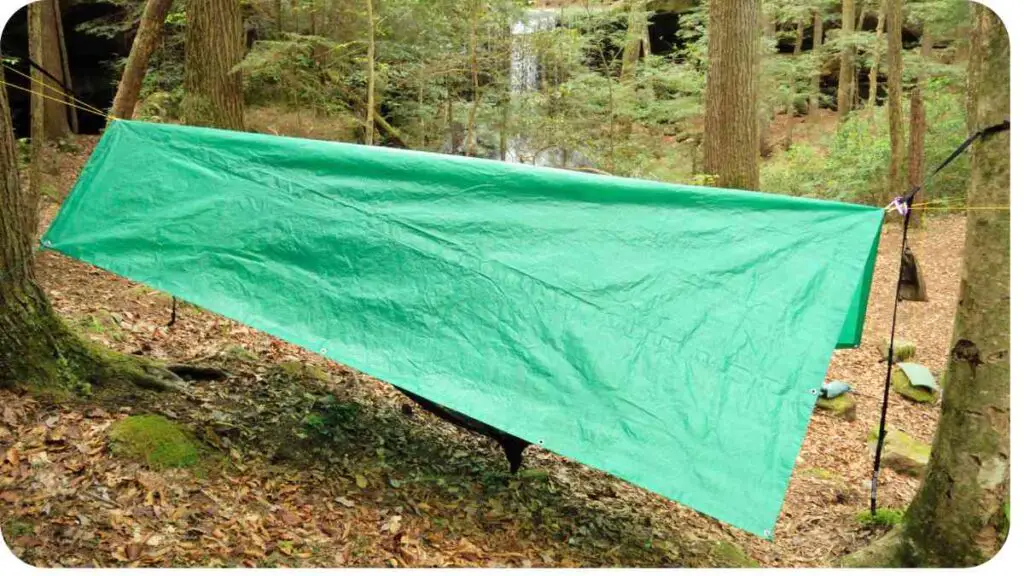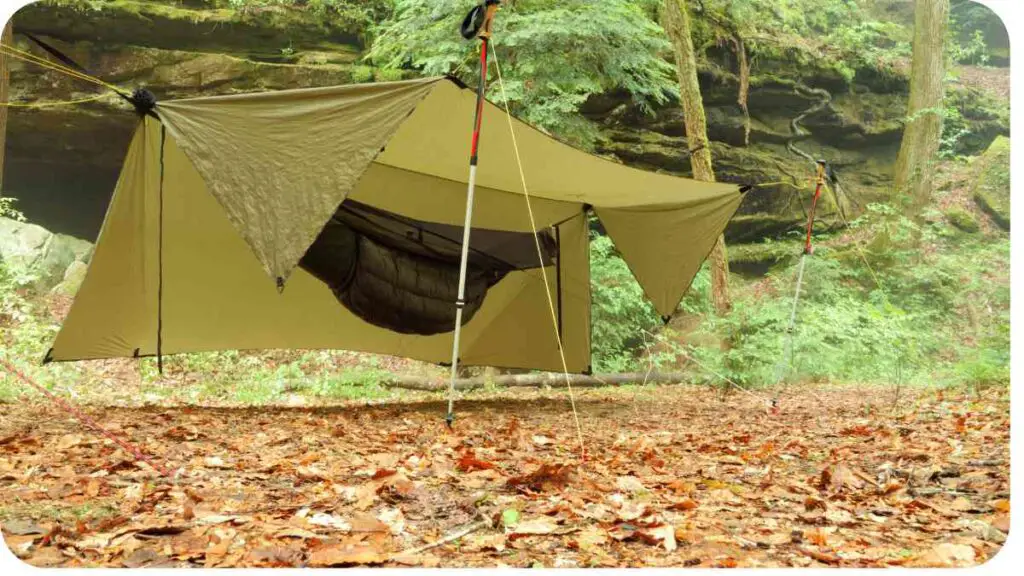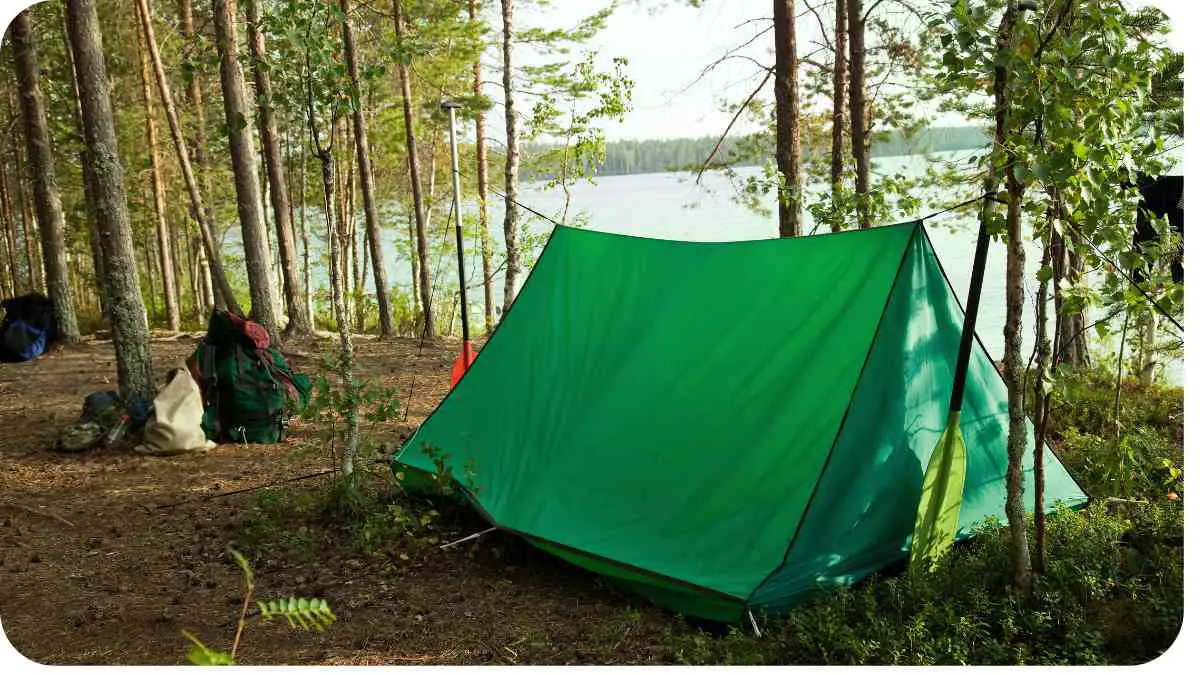Imagine a sunny day at the beach, a picnic in the park, or an outdoor event on a drizzly afternoon. What do they all have in common? The need for shelter! That’s where a tarp canopy comes in handy.
In this comprehensive guide, we’ll walk you through everything you need to know about using a tarp as a canopy cover, from selecting the right tarp to setting it up like a pro.
| Takeaways |
|---|
| 1. Tarps can be transformed into versatile canopy covers for outdoor shelter and protection. |
| 2. Selecting the right tarp material and size is crucial for durability and effective coverage. |
| 3. Proper setup and securing techniques are essential for stability, especially in windy conditions. |
| 4. Enhancements like side panels and decorative elements can personalize and improve the functionality of your tarp canopy. |
| 5. Regular maintenance and care can prolong the lifespan of your tarp canopy, ensuring long-term enjoyment. |
2. Understanding the Basics of Canopy Covers

Before we dive into the specifics, let’s establish what a canopy cover is and why it’s essential. A canopy cover, simply put, is a sheltering structure used outdoors to protect against the elements. It can shield you from rain, harsh sunlight, and even provide a cozy spot for gatherings. Typically, canopy covers come in various forms, including pop-up tents, umbrellas, and tarps.
When rejuvenating your canopy, sealing is crucial. Learn how to seal a canopy effectively to enhance durability and weatherproofing, ensuring long-lasting protection for your outdoor space.
3. Selecting the Right Tarp for Your Canopy
Not all tarps are created equal when it comes to serving as a canopy cover. The key is to choose a tarp that’s durable, waterproof, and appropriately sized for your needs. Here are some factors to consider:
- Material: Opt for a heavy-duty material like polyethylene or vinyl for longevity.
- Size: Measure the area you need to cover and choose a tarp that provides adequate coverage with some overlap.
- Waterproofing: Look for tarps with waterproof coatings to ensure protection from rain.
- UV Resistance: If you’ll be using the canopy in sunny conditions, UV-resistant tarps can prevent fading and damage from prolonged exposure to sunlight.
To help you make an informed decision, here’s a table outlining different tarp options and their features:
| Tarp Type | Material | Size | Waterproofing | UV Resistance |
|---|---|---|---|---|
| Polyethylene | PE | 10′ x 12′ | Yes | Yes |
| Vinyl | PVC | 12′ x 16′ | Yes | Yes |
| Canvas | Cotton Canvas | 8′ x 10′ | No | No |
Now that you’ve chosen the perfect tarp for your canopy, let’s move on to setting it up!
4. Setting Up Your Tarp Canopy: Step-by-Step Guide
Setting up a tarp canopy may seem daunting at first, but with the right approach, it’s a breeze. Follow these steps for a smooth setup process:
- Choose a Location: Find a flat, open space where you want to set up your canopy. Ensure there are no obstructions overhead or below.
- Spread Out the Tarp: Lay the tarp flat on the ground with the waterproof side facing up. If your tarp has grommets (metal-reinforced holes), position them at the corners and along the edges for easy attachment.
- Secure the Corners: Use stakes or heavy objects to anchor the corners of the tarp to the ground. Pull the tarp taut to prevent sagging.
- Raise the Center: If you want a peaked canopy, insert a pole or sturdy support in the center of the tarp and raise it to create a peak. This will help water drain off more effectively.
- Attach Additional Supports: Depending on the size and shape of your canopy, you may need to add additional supports along the edges or corners for stability. Use ropes, bungee cords, or poles as needed.
- Adjust for Weather: If it’s windy, consider adding extra anchors or tying down the edges of the tarp to prevent it from blowing away. You can also lower one side of the canopy to act as a windbreak.
Maintain your boat canopy’s integrity by promptly patching any damage. Explore our guide on how to patch a boat canopy to ensure your maritime adventures remain safe and enjoyable.
Essential Materials for Setting Up a Tarp Canopy
Here’s a handy table listing the essential materials you’ll need for setting up a tarp canopy:
| Material | Purpose |
|---|---|
| Tarp | Main canopy cover |
| Stakes | Securing corners |
| Ropes | Additional support |
| Poles | Center support (if needed) |
| Bungee cords | Securing edges (optional) |
| Heavy objects | Anchoring corners |
With your tarp canopy set up, it’s time to ensure it stays put even in adverse conditions.
5. Securing Your Tarp Canopy: Tips and Tricks
Securing your tarp canopy is crucial to ensure it remains stable and functional, especially in windy or rainy conditions. Here are some tips to help you secure your canopy effectively:
- Use Proper Anchoring: Make sure your stakes are driven securely into the ground to prevent them from pulling out. For added stability, consider using longer stakes or anchors designed for soft or hard ground.
- Tighten Ropes and Cords: Check that all ropes and cords are tightened properly to keep the tarp taut and prevent flapping in the wind. Adjust as needed to maintain tension.
- Double-Up on Tie-Downs: In windy conditions, use multiple tie-down points along the edges of the tarp to distribute tension evenly and reduce the risk of tearing or damage.
- Reinforce Grommets: If your tarp has grommets, reinforce them with additional loops of rope or cord to prevent them from tearing out under stress.
- Monitor and Adjust: Periodically check your tarp canopy during use to ensure it remains secure. Adjust stakes, ropes, and other fasteners as needed to maintain stability.
Common Tools and Materials for Securing a Tarp Canopy
Here’s a table listing common tools and materials you can use to secure your tarp canopy effectively:
| Tool/Material | Purpose |
|---|---|
| Stakes | Anchoring corners |
| Ropes | Tying down edges and corners |
| Bungee cords | Providing additional tension |
| Carabiners | Attaching ropes securely |
| Tarp clips | Clamping onto tarp edges |
| Sandbags | Weighting down corners |
By employing these securing techniques, you can ensure your tarp canopy withstands whatever Mother Nature throws its way.
6. Enhancing Your Tarp Canopy

While a basic tarp canopy provides essential shelter, you can take it to the next level with some creative additions. Here are a few ideas to enhance your canopy experience:
- Side Panels: Attach additional tarps or fabric panels to the sides of your canopy to create a more enclosed space and provide extra protection from wind and rain.
- Decorative Elements: Add string lights, bunting, or fabric drapes to personalize your canopy and create a festive atmosphere for events or gatherings.
- Mosquito Netting: Install mosquito netting around the perimeter of your canopy to keep pesky insects at bay while you enjoy the outdoors.
- Flooring: Lay down a tarp or outdoor rug underneath your canopy to define the space and protect against moisture or uneven ground.
Elevate your outdoor deck experience by adding a stylish canopy. Discover how to put a canopy on your deck with our step-by-step instructions, transforming your deck into a shaded oasis.
Additional Accessories for Tarp Canopies
Explore these additional accessories to customize and enhance your tarp canopy:
| Accessory | Purpose |
|---|---|
| Side panels | Added protection from elements |
| String lights | Decorative lighting |
| Mosquito netting | Insect protection |
| Outdoor rug | Flooring for comfort and cleanliness |
With these creative additions, your tarp canopy will not only provide practical shelter but also serve as a stylish and inviting outdoor retreat.
Don’t let a hole ruin the functionality of your canopy. Follow our guide on how to fix a hole in a canopy to swiftly mend any damage, preserving the integrity and aesthetics of your outdoor shelter.
Now that your canopy is set up and enhanced, let’s discuss how to maintain it for long-lasting use.
7. Maintenance and Care for Longevity
Proper maintenance is key to extending the lifespan of your tarp canopy and ensuring it remains in optimal condition. Follow these maintenance tips to keep your canopy looking and functioning its best:
- Regular Cleaning: Periodically clean your tarp canopy to remove dirt, debris, and stains. Use a mild detergent, soft brush, and water to scrub the surface gently. Rinse thoroughly and allow it to dry completely before storing.
- Inspect for Damage: Routinely inspect your canopy for any signs of wear, tear, or damage, such as holes, frayed edges, or weakened seams. Repair minor damage promptly with patching tape or adhesive, and consider replacing heavily damaged sections as needed.
- Store Properly: When not in use, store your tarp canopy in a clean, dry, and well-ventilated area away from direct sunlight and moisture. Avoid folding or storing the tarp while wet to prevent mold and mildew growth.
- Protect from UV Exposure: If your canopy will be exposed to prolonged sunlight, consider applying a UV-resistant coating or treatment to help prevent fading and deterioration of the material over time.
Effortlessly manage your canopy tent with proper lifting techniques. Explore how to lift a canopy tent safely and efficiently, ensuring hassle-free setup and takedown for all your outdoor events.
By following these maintenance practices, you can prolong the lifespan of your tarp canopy and enjoy many seasons of reliable shelter and protection.
8. FAQs About Tarp Canopies
Q: Can I use a tarp canopy in windy conditions?
A: Yes, but it’s essential to properly secure the canopy with stakes, ropes, and other anchors to prevent it from blowing away. Additionally, consider lowering one side of the canopy to act as a windbreak.
Q: How do I clean a tarp canopy?
A: Clean your tarp canopy with mild detergent, water, and a soft brush. Avoid harsh chemicals and abrasive scrubbing, as they can damage the waterproof coating and fabric.
Q: Can I customize the size and shape of my tarp canopy?
A: Yes, you can trim or modify the size and shape of your tarp canopy to fit your specific needs. However, be cautious when cutting or altering the tarp to ensure it remains structurally sound and waterproof.
Q: What should I do if my tarp canopy gets damaged?
A: Repair minor damage promptly with patching tape or adhesive designed for outdoor use. For significant damage, consider replacing the affected sections or investing in a new tarp.
9. Conclusion
Transforming a tarp into a canopy cover is a versatile and cost-effective solution for outdoor shelter and protection. By selecting the right tarp, setting it up correctly, and incorporating creative enhancements, you can create a comfortable and inviting space for various outdoor activities. With proper maintenance and care, your tarp canopy will provide reliable shelter for years to come, ensuring you can enjoy the outdoors in any weather condition.
Further Reading
For more information on creating shade canopies and DIY tarp projects, check out these helpful resources:
- Canopies and Tarps – How to Make a Shade Canopy with a Tarp: This comprehensive guide provides step-by-step instructions for making a shade canopy using a tarp, perfect for outdoor events or backyard lounging.
- Instructables – Tarp and PVC Canopy Lean-to Workspace: Learn how to build a lean-to workspace using tarps and PVC pipes with this detailed tutorial from Instructables.
- Bushcraft Wild – DIY Tarp Canopy: Discover innovative ways to create a DIY tarp canopy for bushcraft and outdoor adventures with tips and techniques from Bushcraft Wild.
FAQs
Can I use any type of tarp to make a canopy?
Yes, you can use various types of tarps, including polyethylene, vinyl, and canvas, depending on your specific needs and preferences.
How do I secure a tarp canopy in windy conditions?
To secure a tarp canopy in windy conditions, use proper anchoring with stakes, ropes, and additional tie-down points. Consider lowering one side of the canopy to act as a windbreak.
Can I customize the size and shape of my tarp canopy?
Yes, you can customize the size and shape of your tarp canopy by trimming or modifying the tarp to fit your space and requirements. Be cautious when altering the tarp to ensure structural integrity.
What should I do if my tarp canopy gets damaged?
For minor damage, repair it promptly with patching tape or adhesive. For significant damage, consider replacing the affected sections or investing in a new tarp for optimal performance.
How do I clean and maintain my tarp canopy?
Clean your tarp canopy regularly with mild detergent, water, and a soft brush to remove dirt and stains. Store the canopy properly when not in use to prevent damage from sunlight and moisture.

I am Hellen James, a professional handywoman with expertise in improving home and garden spaces by using pergolas, gazebos, and tents.


